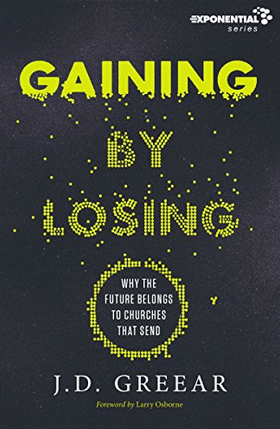 AND: The Gathered and Scattered Church
AND: The Gathered and Scattered Church
by Hugh Halter and Matt Smay
A tension often exists between the modalic and sodalic elements of the church. This book addresses that tension and suggests ways for the two to work together. The modalic arm of the church is the one with which most of us are more familiar. It is the “gathered” church, which is usually stable, organized, and centralized in a building or some sort. Caring for people is usually the focus of such churches. The sodalic arm of the church is often represented by parachurch organizations and small missional groups which focus on reaching the unreached, making disciples, serving the marginalized, and otherwise engaging in mission outside the walls of the church building.
The modalic version of church can easily develop primarily into a programmatic attractional model which focuses most of its time and resources on presenting well-orchestrated Sunday services. Modalic pulls toward the center.
Sodalic versions of the church are sometimes called “missional” and are often versions of “simple church,” which focus more on relationships, discipleship, and mission. Ideally, sodalic thrusts outward.
Halter and Smay contend that every church is both modalic and sodalic; although, individual churches will tend to be more one than the other.
The thesis of this book is that instead of competing with one another, the modalic and sodalic should embrace and support each other. This will allow both expressions to do what they do best and contribute to the overall health of the church.
Proponents of the sodalic wing of the church argue that the modalic has been overemphasized, has become the cultural “norm,” and hinders God’s mission – the development of disciples who make disciples.
American Christians have been conditioned to expect churches to meet their needs instead of being challenged to be on mission. Because of this, sometimes it feels as if asking people to be missional is like trying to “sell rocks.” [Halter, Hugh; Smay, Matt. AND (Exponential Series) (p. 23). Zondervan. Kindle Edition.]
Many sense that God is moving churches toward more collaboration, but missional leaders may fear losing their missional identity if they venture into partnership with the modalic vortex that pulls people to serve the church instead of thrusting them outwardly into the community. Smay and Halter developed a “hybrid” church in Denver called Adullam that blends both missional and modalic elements. They insist that some elements of the church should be centralized (modalic); whereas, others should be decentralized (sodalic). (p.26) The goal should be to see “fans…turned into followers, disciples…made into apprentices, AND consumers become missionaries.” (p.26) They encourage churches to…
…live a fluid organic Christianity AND … [have] enough structure to provide for any level of growth God wants. (p.26)
We want to create a cohesive balance between the scattered communities and the gathered corporate movement. (p. 64)
Moving toward the AND
AND was written to help churches, whether they began missionally and have grown to the point of needing more structure or started as a modalic structure and now recognize the need for more mission. It also proposes that sometimes the modalic and sodalic will choose to partner, each embracing the other without either losing its identity in the process. The modalic and sodalic are two sides of the same coin.
The authors spend quite of bit of time describing what it means to be missional or sodalic, since that has been their own journey. They emphasize the need for engaging the culture (“context”) in an “incarnational” way. Developing relationships with people in our community is the only sure way to become a contextual missionary. (p.58)
Halter and Smay suggest that modalic churches can develop the sodalic side of things by identifying, developing, and releasing missional people who will think and act missionally.
If you want your existing church to successfully engage the culture, you don’t begin by telling your people to engage and then bring’em to church. You must start by creating a new environment for them that provides a better witness to the culture and is the best way to see the kingdom lived out in concrete ways. (p. 66)
an existing church must first gather bands of missional people out of the larger body, bring them together, and then begin the process of engagement. All you need is a handful of people who want to pilot an incarnational community. (p. 68)
This can start with what the authors call “pilot communities.”
Addressing Consumerism
The authors call out consumerism for what it is – the enemy of mission. I cannot say it any better than they have.
Consumerism is the self-focused drive to get as much as I can get with the least amount of effort. It coercively shifts the church away from its true call, from valuing giving to getting. It compels us to protect what we already have and only to give away what has become useless to us. It erodes our sense of duty, honor, loyalty, and chivalry to live for the right things and the best things. It gets in the way of leaving a legacy for those behind us because it waters down our present understanding of what it means to follow Christ today. It pushes responsibility and expectations onto others instead of self and exchanges true spiritual growth for ankle-deep personal devotionals and self-help measures. (pp. 73-74)
Consumerism only exists when it is allowed to exist. Like a scavenging raven, it only shows up where the easy food is available. Consumerism can only exist if there’s something to be consumed. (p. 74)
In a sense, they [consumers] give ownership and responsibility to whoever provides for them. They stop growing on their own and no longer dream about the plans God might have for their lives. Hearts that were once growing and alive begin to atrophy; leaders grow weary, and the church shrivels—in numbers and depth of spiritual maturity. (p. 74)
A consumer is not a disciple and a disciple is not a consumer! (p. 75)
AND asks the question that every missional leaders must ask.
If developing people so that they become like Jesus is our grid for evaluating fruitful ministry, then we have to take an honest look at everything else we’ve felt pressure to provide and ask ourselves, “Do these activities, services, processes, staff positions, religious ceremonies, and financial resource allocations actually help us reorient someone’s life direction so they are growing closer to Jesus?” (p. 79)
Making apprentices out of consumers isn’t just a matter of repro-gramming. The problem isn’t behavioral or methodological—or even ecclesial for that matter. The problem is spiritual. (p. 79)
“Nothing good of the Spirit ever comes naturally or easily.” The missional push and the incarnational way of giving your life for others sound really nice, but the reality is that living this way means you don’t get what your flesh wants. You don’t get to keep all the money. You don’t get to do whatever you want with your time. You have to share your house, your stuff, your money, your kids. You have to exchange your ambitions for God’s, your kingdom for his, and you must be available for God to interrupt your nicely scheduled day with needs that will cause you to pull your hair out. (pp. 79-80)
The more missional you want to be, the more incarnational you’re willing to be, the more you release your people out into the world, the more you desire to equip and empower young leaders, the more effective and faithful you want your church to be…the more you’ll have to die to your self. (p. 80)
There’s only one way to overcome the problem of consumerism. Not two or three ways, not a program, not a sermon for you to preach or a class for you to teach. Just one way to break the pattern: You have to remove what they are consuming. (p. 81)
The last quote is the rub. Becoming a simpler version of church will push the consumers away, but it will free up the rest to engage in mission in a greater way. Stripping away the fluff to make room for mission is a painful yet rewarding process.
Halter emphasizes that real discipleship requires spending personal time with people, not just preaching to them on Sundays or even in classroom settings. He states:
We try to live by a simple leadership principle: “Whatever you give your best to will grow.” (p. 86)
They conclude the chapter with this idea.
Pastoring is as much about protecting the flock as it is about growing a flock. It’s about pushing them and challenging them instead of pandering to them. Ultimately, it’s time for leaders to be consumed in a struggle against consumerism. Our collective calling as leaders is to create spiritual pathways for people so they can come out of their old life and find the new life of Christ. (pp. 88-89)
Spiritual Formation for Missional Churches
In some ways, I believe that even the gravity toward consumerism is simply a symptom of how bored our people are with the basic Christian experience. (pp. 91-92)
The above statement should grab our attention. What can churches offer their people that will engage their sense of adventure while being true to Christ’s mission.
Regardless of our specific church form, the process of spiritual formation in our church must help move people out of consumerism and toward the life, actions, and devotion of Jesus. This process must call for change, challenge the status quo, and guide people through the tension of being counter-culture kingdom people. (p. 95)
Missional churches must prioritize equipping their people to be on mission.
This equipping must move people from the classroom and the sanctuary back into homes, the streets, and the natural places of connection with the world. (p. 96)
Many people assume that our primary purpose in coaching our folks to this end is evangelism. Although we do believe that whenever you find people integrating community, communion, and mission, the kingdom becomes tangible and people find Christ, our primary purpose is really spiritual formation, discipleship, or apprenticeship after Christ. We ask people to live this way for themselves! (p. 96)
The authors insist that discipleship must be intentional. It will not just happen on its own. They lay out a model that integrates inclusive community, communion with God, and mission. The outline four steps in the process: observance, preparation, participation, and partnership. (p.102) The authors encourage missional leaders to invite prospective disciples into a deeper level of commitment and preparation.
Calling people to leave their nets, to prioritize God’s mission over their own, to live by faith, to take up their cross, to deny self, and to seek first God’s kingdom and righteous life is what seekers are so desperate to hear. Let me challenge you to take a risk and start inviting people as Jesus did. Begin personally to invite higher-level leaders to your home, give them your best time, and trust that if you’re honest about how hard Christianity is and how their lives will change, God will build his church—the one he’s entrusted to you to lead well. (pp. 110-111)
The disciple making church sets the bar high enough that mere consumers will not choose to go there, but not so high as to discourage people from giving mission a try. The authors give some examples of what a missional lifestyle might look like.
…what does dying look like in real life?” I said, “It’s just living well and being willing to give time, resources, and relationship to people who are looking for what you have. It’s opening your home for dinners, inviting sojourning people into your family time, recreation, and hobbies, and into your spiritual community. It’s not rocket science or martyrdom at a biblical story level, but you do have to die to your natural bent to live exclusively to yourself. You have to let Christ’s mission dictate how you live. It’s really about the direction of your life, not a state of perfection. It’s serious, but it’s also a beautifully whimsical life without legalistic pressure or self-judgment.” (p. 117)
Disciple making requires us to take responsibility for helping others grow.
The Big AND: Gathered and Scattered in Perfect Harmony
In this chapter, the authors more fully address the main theme of the book. They state the challenge as they see it as follows.
When the modalic and sodalic are completely isolated from each other, the church movement as a whole tends to lose its capacity to multiply. (p. 133)
As you can see, God’s church moves forward, reproduces, and survives from generation to generation because of our sodalic calling. Any sodalic work will eventually turn modalic as a result of the need to disciple and nurture the newcomers to faith, but typically, the missional DNA and fervor wanes and static ministry structures set in. There is really nothing wrong with this process…as long as the sodalic continues to push outward. Practically, this can be accomplished by simply forming our church plant teams, pastoral staff, and elder boards with an equal number of both sodalic- and modalic-oriented leaders. Yes, there will be more tension and lively discussions, but it’s all part of the bride working together. (p. 134)
Notice the two sides of the church here in the words of Jesus. There is the sodalic “go” and the modalic “make disciples,” and the sodalic “of all nations” and the modalic “teaching them to obey.” What most people miss is the big AND right in the middle. It’s not surprising! Conjunctions aren’t supposed to get a lot of attention. They just hold a sentence together. But as you can see from our discussion to this point, the AND is huge and it holds the key to grasping God’s bigger design potential for his church. (p. 135)
They make a very powerful statement that should motivate church leaders toward collaboration.
The greater the collaboration, the greater the potential. The more aggressive the partnerships, the more expansive the movement becomes. (p. 136)
Morph: Transitioning from Gathered to Gathered AND Scattered
This chapter shows how the modalic might move toward embracing the sodalic. They encourage leaders to link arms with other leaders and churches in their communities that have the same vision, mission, and heartbeat.
Be part of The Church instead of limiting your focus on your own local church. Be willing to link arms with others who share a common vision and passion for your community. (p. 156)
To Gather or Not to Gather: Is That the Question?
In this chapter the authors encourage leaders to construct mission and ministry so that their people see that they are needed for the mission.
If the vision of the church is not scary, if it doesn’t require everyone to pitch in, if faith is not needed, then folks will stay home and watch the football game. Here’s the bottom line. People get weary of church services when they realize that their participation isn’t necessary for it to continue. On the opposite side, if a person feels that they must be there so that God’s kingdom work can go on, they will give up anything to gather together. This focus on the outside naturally brings excitement and integrity to gathering together on the inside. (p. 172)
He also addresses the “what do we do with the kids?” question by promoting the integrated approach.
I do find it interesting that as Western Christians we so quickly panic when we have to think beyond programmatic ministry models. In other cultural contexts, if you asked a Hindu, Buddhist, or a Christian what they do with their kids during religious services, you’d probably get a weird response like, “You include them.” This really shows how church has dis-integrated our experience to the point where we don’t think we as big people can grow with God if our children are with us.(p. 181)
The last chapter deals with leaving a spiritual legacy.
All parents want the best for their kids, but as we mentioned in the chapter on consumerism, God’s highest goal for our children isn’t to keep them busy and safe. Our role as stewards over the spiritual life and legacy of our kids is to model a holistic life of apprenticeship under Jesus—to invite them and include them in as much as you can and to trust that God will grow them, protect them, and use them to change the world. This certainly can include children’s education during our gathering times, but it must include much more. Children will follow what they’ve seen us do. If they see us go to church and live a typical, normal life, that’s what they’ll think being a Christian is all about. But if they see their parents actually live out the gospel—community, sacrifice, inclusiveness with everyone, and mission to the poor and needy—they will follow suit. The more decentralized and organic your church rhythms, the more creative and intentional your people will need to be with each other and for each other, with and for their children. (pp. 182-183)
Conclusion
I highly recommend this book to anyone who desires to help the church fulfill both its pastoral and sending responsibilities. It can inspire you and give you some practical ways to implement your vision.



